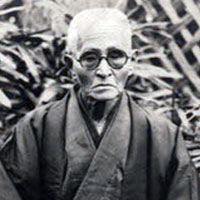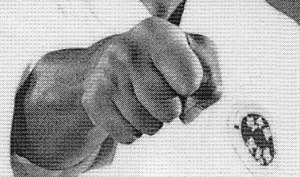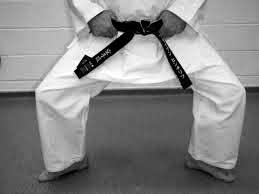Sha-ken Tsuki and Shimata Dachi
You may wonder why your Sensei corrects your fist to hold an unusual angle, neither vertical nor horizontal, but somewhere in between, especially if you have some experience with Shotkan or Shito-ryu Japanese styles.
Countless punches may have conditioned you, and the unanswered question may have faded into obscurity.
Let the question resurface and seek an answer once again...
Kyan’s Karate
 For its core principles, the Shorin-Ryu Seibukan Karate style is heavily based on Kyan's Karate system.
For its core principles, the Shorin-Ryu Seibukan Karate style is heavily based on Kyan's Karate system.
Hanshi Zenryo Shimabukuro, the founder of Seibukan, was a long-term student of Sensei Chotoku Kyan (1870-1945), one of the pioneers of Okinawan Karate, and thus all martial philosophy and application were undoubtedly passed down to the Seibukan system of Karate.
Hardly 4 feet 10 inch tall, frail stature Kyan Sensei had to formulate many unorthodox tactics to his style to combat against much stronger and larger opponents. He was fortunate to have a high level of education and was very fluent in Chinese and Japanese languages apart from the Okinawan native language. His education in Bio-mechanics helped him to modify scientifically many conventional Karate applications in the most effective manner..
Why an angled first punch (Sha-ken Tsuki ) ?

Traditionally Karate punches have vertical fist punch with 180 degree rotation upon finish. Okinawans/Japanese are generally short people who cannot execute an effective upper face level punch against a taller person, since the lower part of the fist contact with the target, may result wrist injury. Kyan Sensei changed the angle of the first to 45 degree or 3/4 angle punch with a slight sideways bend to make fist two knuckle aligned to the radial bones of the forearm. He designed the sha-ken or angled punch in such way that index knuckle hit 60 percentage and the middle knuckle hit 40 percentage on the target to neutralize the pressure on the fist. This modification of fist makes punch at any angle without inuring the wrist and execute maximum power and speed of the same.
Kyan Sensei also believed that when fist comes to 90 degree at the end of the punch, forearm muscles tense and it decelerate punching speed whereas the 45 degree angle is the natural angle of the hand that does not affect the acceleration.
The 3/4 twisting punch also allows the whipping action generated from the waist twist to coordinate with the punching motion. The full twist punch require either a recoil of the hip or a reverse twist of the hip ( ie. double twist) as punch contact with the target. This allows to gain maximum rotation of the fist without interrupting the whipping motion of the waist and hip.
Another reason may be the 45 degree protection from getting damaged to the important meridians/nerves running along the side of the forearm by the blocking hand of the opponent.
Shimata Dachi

Kyan Sensei designed a shorter Shiko Dachi (Square stance or four thigh stance) to meet the stance lower without sacrificing the mobility from the stance. The traditional Shiko dachi used in the style like Goju-Ryu is a little wider than this with the disadvantage of transition to another movement. The purpose of the smaller stance was to enable jumping into and away from an attack where low stands gives maximum stability. Due to his small size, Kyan Sensei wanted to get underneath an attack which would provide an opening for a counter in an attack. This is a valuable contribution to Seibukan Karate system by the great teacher.
Let us say “Arigatou gozaimasu” to Grand Master Kyan Sensei who enriched the Okinawan karate system of “More effect with less effort” with his unorthodox novel tactics in Karate.